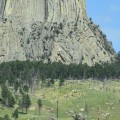Since 1893, people have been attempting to conquer the Devil's Tower National Monument. That first climb was achieved by two local ranchers and a 350-foot stake ladder that was crashed into a crack. This staircase is still visible today, located 200 feet above the tower path. The techniques used to climb Devils Tower can be a challenge even for experienced climbers. Climbing the monument requires one to jam the parts of the body, usually the feet and hands, but sometimes the shoulders, arms, knees and legs, in the cracks and use friction and opposing forces to ascend up the columns.
Even with prior climbing experience, Coveney admitted great difficulties during certain stages. It was June 1972 when Sanders first saw the national monument. With around 2,000 ascents to the 5,112-foot tower, Sanders is dedicated to sharing the experience of conquering and being one with the tower. It's considered a challenging route, but today there are much more difficult routes to find in Devils Tower. The first climb was made on July 4, 1893, when William Rogers, a cowboy who lived near Devils Tower, made the ascent.
Otherwise, Devils Tower is a very friendly place for climbers and is open for climbing every day of every month of the year. There is only one court on the north face of Grand Teton in Wyoming that is as difficult in its path, as this crack is in the Devils Tower. On a gloomy day in the plains of eastern Wyoming, a small group of travelers decide to detour to a place known as the Devils Tower. Joyner, custodian of the Devils Tower National Monument, welcomed them with water canteens that they gratefully received. In May 1937, Fritz Wiessner submitted a formal request to the National Park Service to climb the Devils Tower National Monument.
Most of the group were skeptical about the detour, as Devils Tower was not a place for rock climbing. But that's exactly what Frank Sanders is, and he's spent the last 45 years climbing Devils Tower in Wyoming. In a broader sense, it wasn't just the route he climbed, but the fact that Wiessner demonstrated that Devils Tower was truly scalable. Wiessner presented his cat shoes, a python and a carabiner to the museum at the Devils Tower headquarters, and a short piece of the rope used. Today, an average of 5,000 people follow in the footsteps of Wiessner, Coveney and House as they face the challenge of climbing up this iconic national monument.






